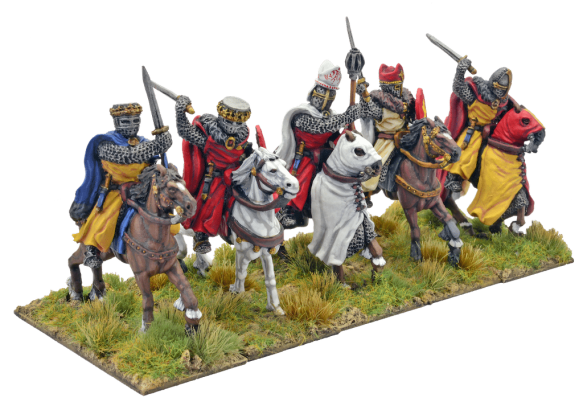If they did not fight with their own hands, those clerics closely in tune with knightly standards could at least clear the way for the lay warriors. At a critical moment in the expedition to Jaff a, knowing that Gautier, Comte de Brienne and Comte de Jaffa, was under sentence of excommunication by the Patriarch of Jerusalem (the issue being ownership of a tower in Jaffa), the bishop of Ramleh took charge, declaring, in a scene that, again, could have been lifted from a chanson de geste:
Don’t let your conscience worry you because the patriarch won’t absolve you, for he’s in the wrong, and you’re in the right. I myself absolve you in the name of the Father, the Son and the Holy Spirit. And now let’s at them!
The result was that “they dug their spurs into their horses (ferirent des esperons)” and attacked.
In an even more tense moment, as Joinville and his knights realize that they will be captured by their enemies and are only debating to which party of Saracens to yield, a cellarer in his employ suggests that they not surrender at all. “We should all,” he counsels, with words that, once again, could have been drawn from a sermon or miracle story, “let ourselves be slain, for thus we shall go to paradise (Je suis d’avis que nous nous laissions nous tuer; ainsi nous irons tous en paradis).” Tersely, Joinville comments, “But we none of us heeded his advice (Mais nous ne le creumes pas).”
The value of this evidence from the Lisbon and Egyptian crusades is heightened by its congruence with evidence from chansons de geste. As pictured in the Couronnement de Louis, the Chanson de Guillaume, the Chanson de Roland, the Charroi de Nimes, knights showed a remarkable independence of spirit. Th ey interpreted the hard campaigning and warfare of their profession, even when carried out against non-Christian enemies, in terms more compatible with lay aristocratic social norms than with clerical treatises and sermons. Th ey thought of themselves as serving their lords or the lord king as guarantor of the order of their world rather than the pope. Th ey defended a region, a realm, a homeland, more than a religion or moral ideal. If fighting the enemies of the faith was laudable, they insisted on the worth of chivalric combat per se.
Other knights on the stage of history and their fellows on the pages of imaginative literature directly assert the rectitude of their own order against clerics who would play the warrior. Th is was trespassing on the preserve of the sacred labor of the knightly ordo. Just before the Battle of the Standard, fought between the English and the Scots in 1138, Archbishop Thurstan of York boldly announced that he and his parish priests bearing crucifixes would join the English fighters. In a scene that parallels contemporary chanson, the archbishop solemnly gave the English forces, gathered before him in arms, God’s blessing and forgiveness after they had accepted private penitence and a general three-day fast with alms. Although the archbishop again declared his determination to join the army in battle, English barons firmly informed him that he should return to his prayers and religious duties and leave the fighting to them “as their order required.” A century and a half later, when on another northern field of battle the English and Scots again fought, another bishop was told to act within his ordo, by knights confident of their own. At Falkirk in 1298, Anthony Bek, bishop of Durham, actually commanded one division of the English army. Yet when he tried to restrain his fighters who were eager to advance, these proud warriors told him plainly, “It is not for you, bishop, to teach us about knightly matters, when you should be saying mass. Go and celebrate mass and leave us to get on with our military affairs.” The word ordo is missing, but the knights assert a strong sense of the proper function for clerics and for knights.
Some clerics were clearly sensitive to the basic knightly argument. Caesarius of Heisterbach tells of a fearful priest who carried a sword on a night journey. Encountering a hideous man whose figure suddenly grew to the height of the trees, he fled in terror, only to be told by lay brothers in a monastery what he should have known: the devil fears a psalm, not a sword. In other words, he was acting outside the principles of his ordo. Richard de Templo, an Augustinian who incorporated the Estoire of Ambroise into his chronicle, at one point exclaims, “How distant, how different is the life of contemplation and meditation among the columns of the cloister from that dreadful exercise of war.”
That such conversations can likewise be found in romance shows their widespread dissemination. In the Middle English Sultan of Babylon, the warrior Ferumbras makes the point. While still a pagan (before his defeat by the hero Oliver converts him to Christianity), he unhorses a fighter leading a contingent out from Rome and is surprised to find the man is tonsured. The unhorsed man is, in fact, the pope.
Philippe de Dreux (or Philip of Dreux, 1158-1217) was the epitome of the warrior bishop. Ally and cousin of King Philippe II of France, the Bishop of Beauvais was an active opponent of Richard the Lionheart in north-west Europe, both before and after their participation in the Third Crusade. He first campaigned in the Holy Land as part of Henri de Champagne’s expedition in 1180, but also joined his brother, Count Robert II de Dreux, for the Albigensian Crusade in 1200. Fighting at his brother’s side again at the Battle of Bouvines in 1214, Philippe captured William Longespée, Earl of Salisbury.
